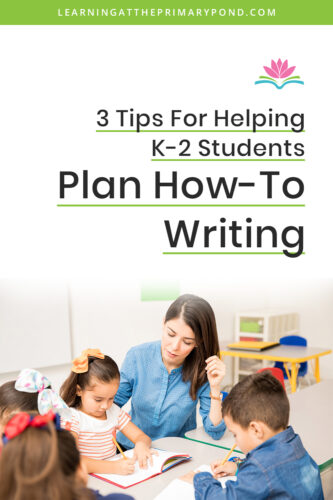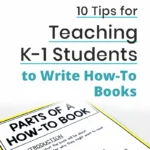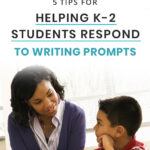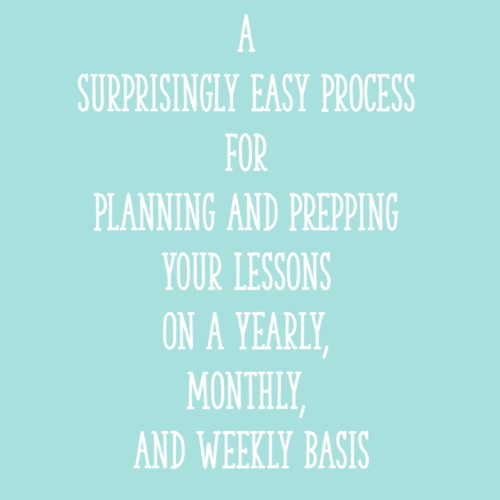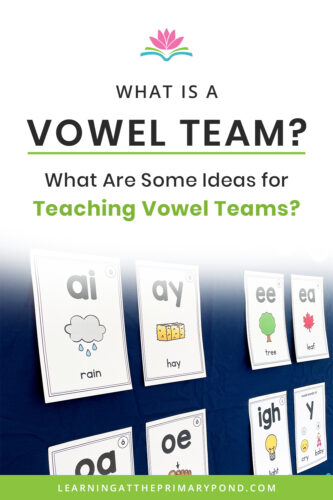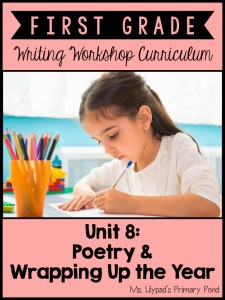How-to writing, in theory, should be one of the easiest things for students to do! You’re literally asking them to tell about something they already know how to do. Why, then, can it seem challenging to get K-2 students to successfully write a how-to piece?
Without guidance for how-to writing, students might do the following:
- pick topics that are too general (i.e. “How to Play Baseball”)
- attempt to write about something they lack experience in (i.e. “How to Drive a Car”)
- leave out major steps in their writing pieces (i.e. forgetting the step about turning the oven on in “How to Make a Pizza”)
What I’ve found is that the planning portion of how-to writing is key in the ultimate success of the final product! Students need time and a solid process for planning it all out, instead of just diving in.
In this post, I have a video (and transcript, if you prefer to read) that will provide some tips on how to get your Kindergarten, 1st grade, and 2nd grade students to plan out their how-to writing.
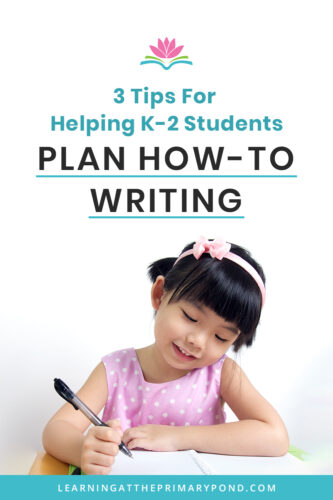
Watch the video to find out what tips I have to offer!
Read the transcript here:
“Hey, I’m Alison from Learning At The Primary Pond. I’m a literacy specialist and in this video I’m going to share three specific tips to help you help your Kindergarten, first grade, or second grade students with how-to writing. Before we dive in, if you haven’t subscribed to my channel (https://www.youtube.com/@learningattheprimarypond) yet, make sure to do that now, and then also hit the little bell so that you don’t miss any of the brand new videos that I post about teaching literacy in K2.
I think the fancy name for how-to writing is procedural nonfiction. It’s literally how-to, for example, fly a kite. On a more adult scale it’s how-to assemble this piece of furniture. It’s instructions. It’s teaching the reader how-to do something. This can be true of many genres, but it can be hard to get kids going and get them writing with the level of detail you’d like. They may come up with something very short and then just be like, I’m done.
So I have a question for you. So that other teachers know that they’re not alone, if you’ve ever had students and you give them a writing assignment and they finish very quickly after just a couple of sentences, and then they tell you I’m done, just let me know in the comments. It’s that they don’t have the level of detail that you’d like them to have. So just type ‘done’ in the comments so that other teachers know that they are not alone because this is a very common issue.
Now, I want to give you a little background before I get into these tips and actually show you some of the resources that I use. I want to talk about how I introduce how-to writing. My favorite way to do this is to have the kids work together. Possibly they can work together to help me make some sort of recipe. So this could be fruit salad. It could be trail mix. Hopefully you can do some kind of food in your classroom. Obviously be aware of food allergies and be careful about that. But you could do a craft or how-to make a paper plane if you can’t do food.
Let’s just talk about the example of trail mix. That’s super fun. So I kick off my first grade how-to writing unit with a lesson on how-to make trail mix and we just go through the process of making it as a class. Then afterward, it might be later that day or the next day, I come back and I ask them if we wanted to teach a friend, or someone in another class or someone in your home, how-to make trail mix. What would you say? What did we do first? Then they’ve had that very meaningful experience of making the trail mix so then at that point we verbally talk through and they’re just retelling me all the steps that we followed to make this trail mix.
Then after they’ve talked through it, I show them on paper, how-to take those steps and turn it into writing. Then at the end, I tell them hey, the thing that we just did right here, this is called how-to writing. We’re teaching our reader. We could give this to someone else and they would know how to make trail mix.
https://www.primarywritingsuccess.com/So it’s a very meaningful, memorable experience for them just to kick off the unit. That example lesson, by the way, is part of a comprehensive writing and grammar program that I have. It’s called Primary Writing Success (https://www.primarywritingsuccess.com/). I’ve got it for kindergarten, first grade and second grade and I will include a link (https://www.primarywritingsuccess.com/) for that program in the notes that go along with the video or the comments.
Let’s talk about these strategies now. Just a little side note before we get into it, it is really helpful to have the kids plan what they’re going to write before they actually produce the how-to piece. So we’re kind of going to talk about that and how-to do it, but we don’t necessarily want to dive right into oh, this is the idea in my head. Let me write it. There’s going to be some planning involved because that can help them produce stronger writing and just make it more coherent.
So onto our tips. Tip number one is to have students brainstorm a list of how-to topics toward the beginning of the unit. So let me show you this sheet. It is so simple.
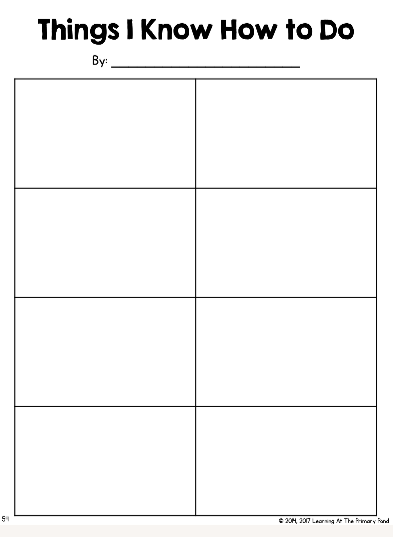
It literally just says things I know how-to do and there’s lots of squares. The purpose of this is to show the kids number one, that they have a lot of stuff to write about. But number two, when they finish one how-to book, I don’t want them sitting there and just being like I’m done. Mrs. Ryan, I don’t know what to write about. No. I want them to come back to this list that they will have, choose another topic and then keep going. ‘Cause typically, especially at that age, the kids will be writing more than one how-to piece during the unit. So this really helps with that.
Now to introduce this, to get them to a point where they can fill this out for themselves, I will help them brainstorm as a class what are some things that we are experts at? So there are things that all of the kids know how to do. We can write that. We can draw little pictures because this doesn’t have to be a written list. They could actually just draw little pictures. This is definitely what I do with kindergarten and you can do it in first grade as well. They just draw little pictures of things that they know how to do.
We kind of brainstorm as a class, make a list. Then we also talk about hey, you might know how to do something that somebody else in the class doesn’t know how to do. Or just because someone else knows how to do it doesn’t mean that you know how to do it and should write about it. So we talk about individual differences as well as brainstorming as a class what are we experts at? So once they’ve seen how to do that, then they go and fill in that little organizer. They keep it in their folders throughout the entire how-to writing unit. You could also copy this uncolored paper so that if they’re done, you can just remind them hey, go to your red sheet or go to your blue sheet when you’re finished and get another idea for your next how-to writing piece.
Oh, another thing you can do when you’re having them brainstorm topics, sometimes kids will choose very broad topics like how-to play soccer. That is very broad. That would probably take an entire manual. So you can help them focus in a little bit on that. We’re going to talk about this example a little bit later, but instead of how-to play soccer, here’s how-to do a corner kick. So something very focused. Zoom in a little bit. So that’s the process of coming up with ideas.
Here’s my tip number two. When they’re ready to take one of these ideas and actually write about it, I want them to think through and even talk through to a classmate the process that they would go do. So I like to have them visualize, close your eyes and visualize. So if we’re going with that how-to do a corner kick example, you’re going to model this for them. You’re going to say first I’m imagining how I would walk over to the corner of the field. Then I’d put the ball on the little corner spot. Next, I’d look up at the field and I’d look to see, which one of my teammates is open. So I’d choose somebody to kick it too. Then I’d take a couple of steps backward from the ball. The ref has to blow their whistle and then I can kick… Run toward the ball, kick it and then I kick the ball to whichever teammate I chose.
So lots of little steps, but we want them thinking that granularly. We want them to think that detailed. So that’s a good example of how you might model. We’re doing this orally. You can have them talk through, have them visualize, even give them time to close their eyes and imagine step by step what they are doing. Then have them talk it through with a partner. That partner can also ask them questions because sometimes when we’re explaining something, even as adults, someone else can kind of see the gaps in the holes more clearly than we can because we’re the expert. So that partner can ask them questions that can clarify and help them add more details as well.
My last tip, tip number three is to have students take their thoughts to paper. So let me show you… here’s an organizer.
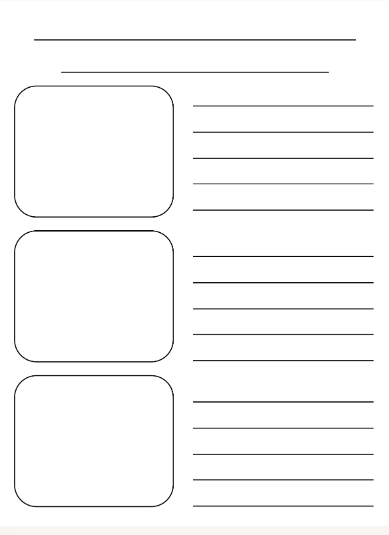
That works well for how-to writing, and the way it works is their little title goes up here, and then here’s just a blank box for a drawing. This is step one. In Primary Writing Success, I have these numbered as an option. So you could literally have them pre-select one, two and three. Or I have some options with more than three steps, four steps. But anyway, the drawing of the step goes here and then you want them to actually write the step here.
Often it can be helpful, especially for K-1 to actually have them start with the drawing and then add the words. Now this is an organizer. I think at first it can be helpful to just have the kids go through a couple of how-to writing pieces and this is all they do. However, eventually what we want them to do is to take each step and turn it either into a page of a book, a multi-page book. It doesn’t have to be that much on the page, page one is step one. Here’s what I do and then there’s a picture of whatever they’re supposed to be doing in step one. Then step two, this becomes a page of a book, etc.
If you’re working with older kids that are actually writing paragraphs, it doesn’t have to be a book. It could be step one is paragraph one. Step two is paragraph two, step three is paragraph three. So when you’re having them… I don’t want to get too far ahead of myself, but when you’re having them take this organizer, that’s complete you want to really model how when they put it in a book they’re going to try to add a few more details.
Now, if we’re talking about kindergarten though, you might have a little picture. You might have a couple of words and you’re good to go. So I’m just offering options to you and the amount that they put on here and even whether or not they turn it into a book or a multi-paragraph piece of writing, it just depends on the level of your kids. Just throwing out some different options.
I hope all of that was helpful. I would love to share this free in-depth training on teaching writing in K2 with you. It’s an hour long, you get a certificate and all that good stuff. I will include a link (https://www.primarywritingsuccess.com/5-secrets-to-getting-k-2-students-to-write-independently-eg) along with this video so that you can learn more about getting access to that free training. Thanks again for watching. I hope this was helpful. Don’t forget to hit the like button, subscribe (https://www.youtube.com/@learningattheprimarypond) and I will see you in the next video.”
Conclusion
I hope these ideas on teaching K-2 students to successfully plan out their how-to writing are helpful to you! If you’re interested in learning more about writing, check out my free webinar: “5 Secrets to Getting K-2 Students to Write Independently.”
Also, if you need a comprehensive writing program that includes all of the materials discussed in the video (and much more), check out Primary Writing Success. Included in Primary Writing Success are:
- lesson plans (for both writing and grammar)
- student materials
- suggested daily schedules
- pacing guides
- professional development videos
Start your free trial week for Primary Writing Success by clicking here!
Happy teaching!
